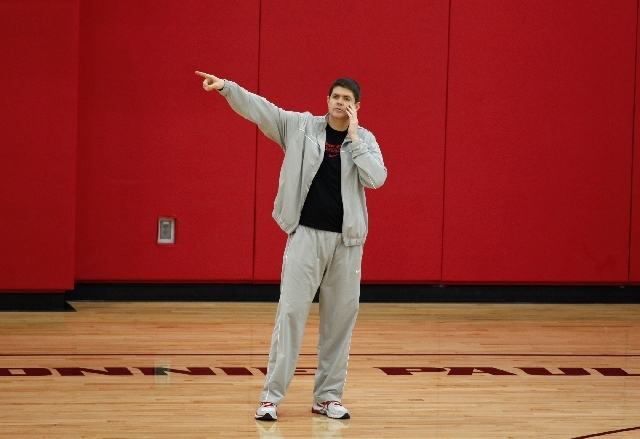Coaches can realize more good than bad with transfer rule
In the swarm of opinion that followed a decision by Katin Reinhardt to transfer out of UNLV’s basketball program this week, an important point was lost: This is why the rule exists.
However anyone feels about Reinhardt bolting the Rebels after averaging the second-most minutes and shots as a true freshman, about a good-but-not-yet-great-player departing a team in which he was afforded the type of freedom most seniors never receive, he had every right to move on.
Kids transfer for all sorts of reasons — lack of playing time, to be closer to family, to play a different position with the misguided notion it will help them make the NBA, to prove a program exists nationally that doesn’t have the word “run” in its marketing slogan.
At day’s end, though, it’s the player’s prerogative, no matter how others view the move or how shortsighted it might prove.
Coaches are up in arms today over there being more transfers in the college game than missed calls, and we all know how inadequate those blowing whistles were last season.
So those drawings X’s and O’s, some far better than others, are calling for sweeping reform when it involves players jumping from one school to another.
Translation: While their fear of the college game trending more and more toward a torrent of free agency has merit, coaches are again thinking in the best interest of, well, themselves.
They have grown tired of the waiver and loopholes that exist within the rule, allowing many transfers to immediately play at their next stop without having to sit out the year Reinhardt now faces at Southern California.
They want everyone to sit, no exceptions, no acceptable reasoning against it.
But the coaches who take issue and question the intentions of fifth-year seniors who have earned an undergraduate degree or those desiring a school closer to an ill relative being immediately eligible are the same ones who over-recruit certain positions, purge those with skills that don’t prove acceptable and often deny a player his transfer to a list of schools longer than the court on which they compete.
Never believe there is a more hypocritical bunch in college athletics than coaches, whose overinflated egos are most always defined by their misuse of power over players wanting to leave.
There have been close to 900 transfers over the past 12 months and, for the most part, those involved will sit a year before again becoming eligible to play.
Teams such as UNLV will benefit from all the movement.
And that’s not a bad thing.
Dave Rice will enter a third season as coach and there is every chance he will start four transfers when tipping off the 2013-14 schedule. He could start five, depending on what preseason workouts bring in terms of execution and need.
It is the reality, and mostly a good one, of what the better Mountain West teams have become.
I’ve never bought into the opinion that several transfers on a team should be seen as a negative, but instead believe it’s on the coach and program to develop such things as chemistry and cohesiveness on and off the floor, no matter from what level players arrive.
It’s true transfers often tug more baggage with them than prep recruits — Jelan Kendrick is a junior college player who eyes starting at point guard for UNLV after previous stops at Memphis and Mississippi and some bizarre behavior along the way — but more often than not a kid can eventually find happiness and produce in the right situation.
It’s a scenario in which the coach must determine a risk/reward ratio and be prepared to accept responsibility if things go wrong. But that doesn’t mean Rice and coaches of such programs as UNLV should stop taking calls from players searching for a new home.
Anthony Bennett was a terrific signing for Rice, but there is a reason so many years passed between a McDonald’s All-American choosing UNLV straight out of high school.
There remains a pecking order within college recruiting that elite teams dominate with the best prep players, and those programs that believe themselves Top 25 caliber (UNLV) but remain on the fringe of such a truth are instead a desirable place for such talented bounce-backs as Khem Birch and Bryce Dejean-Jones and Roscoe Smith.
Nothing wrong with that. Nothing at all. UNLV can win a lot of games with such players. San Diego State will start three transfers next season and, like the Rebels, could have five on the floor at times.
The transfer rule exists for a reason.
In the long run, UNLV will fare much better for it than simply losing a player who sought a different role than the second-most minutes and shots as a true freshman.
Las Vegas Review-Journal sports columnist Ed Graney can be reached at egraney@reviewjournal.com or 702-383-4618. He can be heard from 11 a.m. to 2 p.m. Monday through Friday on “Gridlock,” ESPN 1100 and 98.9 FM. Follow him on Twitter: @edgraney.

















